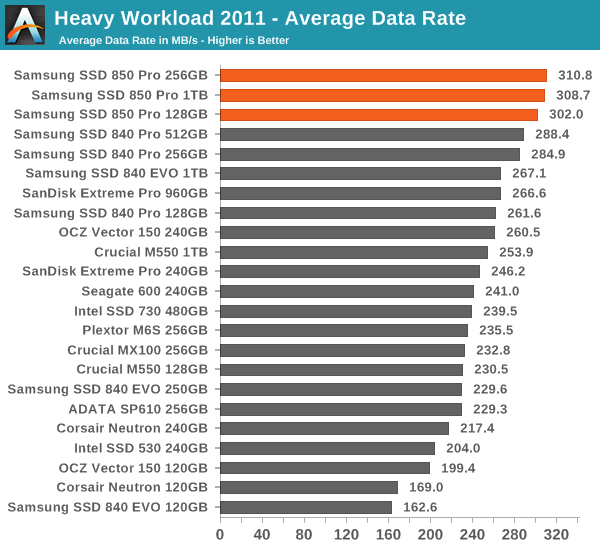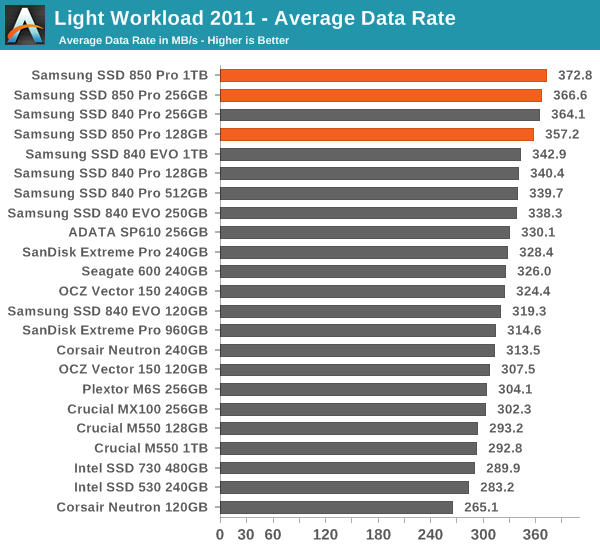Samsung SSD 850 Pro (128GB, 256GB & 1TB) Review: Enter the 3D Era
by Kristian Vättö on July 1, 2014 10:00 AM ESTAnandTech Storage Bench 2011
Back in 2011 (which seems like so long ago now!), we introduced our AnandTech Storage Bench, a suite of benchmarks that took traces of real OS/application usage and played them back in a repeatable manner. The MOASB, officially called AnandTech Storage Bench 2011 - Heavy Workload, mainly focuses on peak IO performance and basic garbage collection routines. There is a lot of downloading and application installing that happens during the course of this test. Our thinking was that it's during application installs, file copies, downloading and multitasking with all of this that you can really notice performance differences between drives. The full description of the Heavy test can be found here, while the Light workload details are here.

The dominance continues in our 2011 Storage Benches. The 840 Pro was already the fastest drive in both suites, so it does not come as a surprise that the 850 Pro takes the lead.











160 Comments
View All Comments
MrSpadge - Tuesday, July 1, 2014 - link
No, it's really "600 MB/s whatever". In reality about 550 MB/s seems to be the maximum. With 300r + 300w full duplex neither read nor write could surpass 300 MB/s.zmeul - Tuesday, July 1, 2014 - link
why I ask thisI see a lot op people putting SSDs in RAID0, and I wonder why ... to me, it seems totally pointless
the system doesn't do only writes or only reads, so what's the point? well, except in the cases where you copy/move some huge files from one matrix to another
Cerb - Tuesday, July 1, 2014 - link
Copying large files, and loading large files. Realistically, you can copy from a new SSD to another at anywhere from 250MBps to 450MBps (including OS/filesystem overhead). That's halved, or worse, copying from an SSD to itself. RAID 0 gives you an approximately linear bandwidth increase. If you don't need a logical or physical separation of data locations, RAID 0 beats a separate drive.When I'm backing up my Bethesda games directory, I wish I had more speed, as it could be done faster in a RAID. However, I only do that one or two times per month (all my saves for all my games are on automatic backup).
For typical light random IO, it very much is pointless.
457R4LDR34DKN07 - Wednesday, July 2, 2014 - link
Easy, say you have 2 sata 2.0 SSD but want sata 3.0 speeds.Kevin G - Tuesday, July 1, 2014 - link
Typo?"I bet many of you would have liked to see the 850 Pro move to the PCIe interface but I understand Samsung's decision to hold on with PCIe for a little while longer."
I think the second PCIe should be SATA.
stickmansam - Tuesday, July 1, 2014 - link
of the "on" could be a "off'Solid State Brain - Tuesday, July 1, 2014 - link
How many P/E cycles does the NAND on this drive support, by SMART data?Kristian Vättö - Tuesday, July 1, 2014 - link
I will test that as soon as I get back from Korea, as well as send you the Extreme Pro data. Sorry for not replying to your email earlier, I kind of lost focus on everything else when I started working on this review :)Solid State Brain - Tuesday, July 1, 2014 - link
No problem, thanks!extide - Tuesday, July 1, 2014 - link
You should actually put up a little pipeline article with all of this data, because it would be interesting to me, and I am sure lots of other users as well.